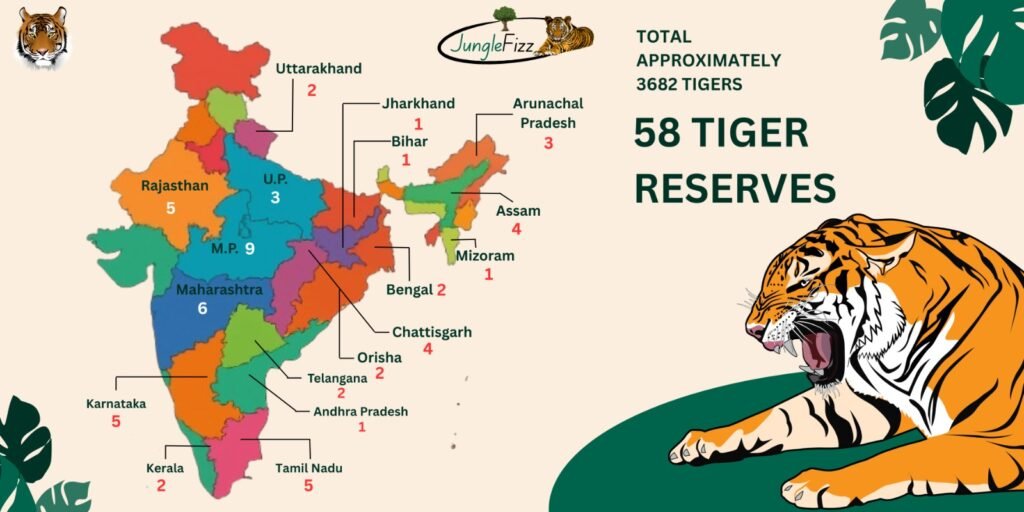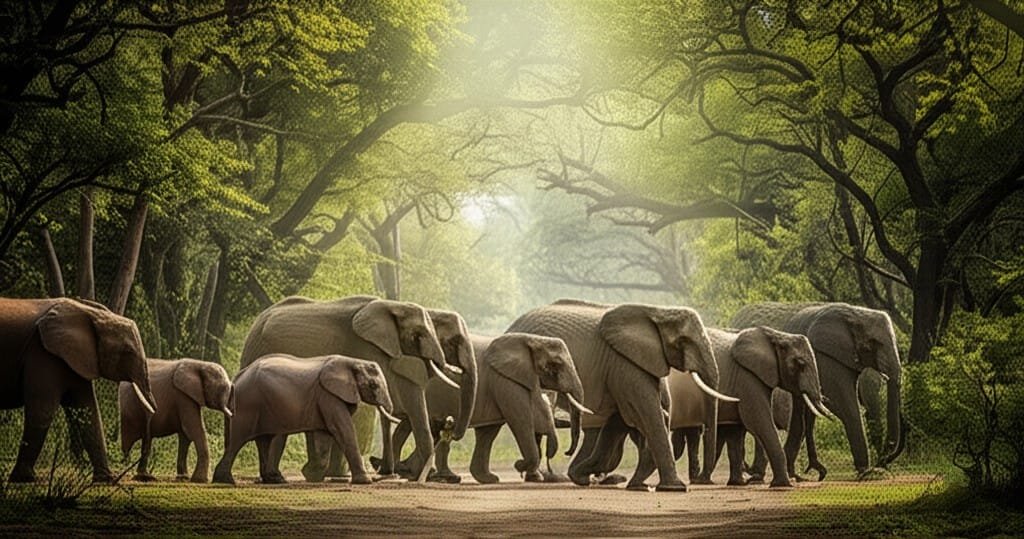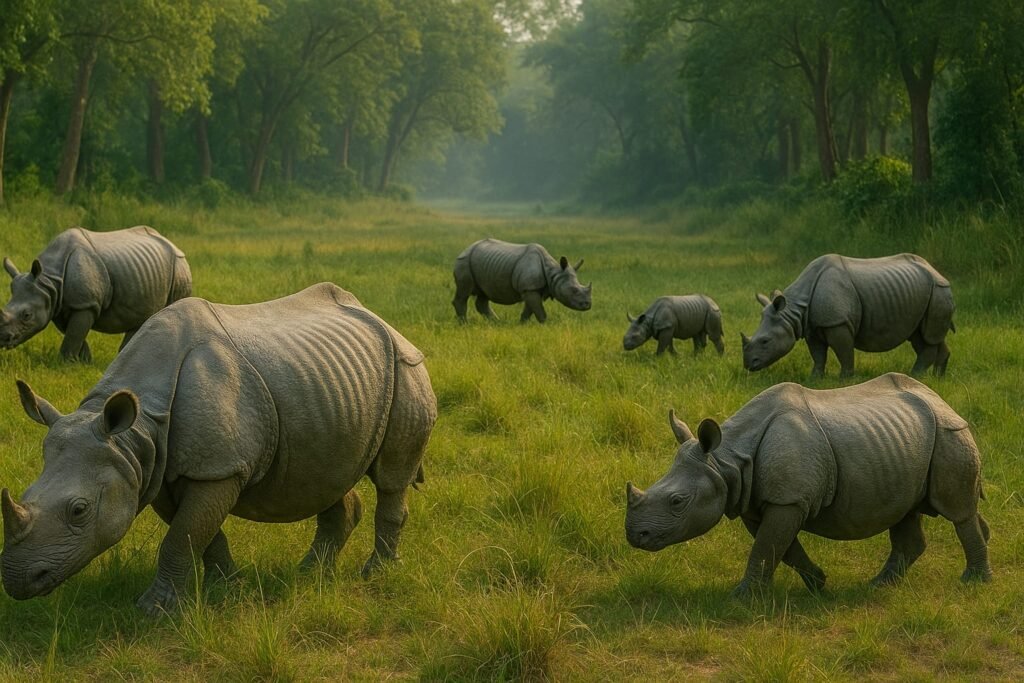In the heart of India’s dense forests, beneath the shade of towering sal trees and across the banks of winding jungle rivers, prowls the symbol of India’s wild soul—the majestic Bengal tiger.
But not long ago, this iconic creature stood on the brink of extinction. The alarm bells had rung, and India stood at a critical crossroads: either act swiftly or lose the tiger forever.
A conservation saga followed, beginning with a bold initiative in 1973—Project Tiger—and culminating in one of the greatest wildlife success stories the world has ever seen: the TX2 goal.
This is the story of how India not only saved its tigers but also led the world in bringing them back from the edge.
Once Upon a Forest: The Ancient Roar of the Tiger
Tigers are among the most ancient and revered animals on Earth. Fossil evidence tells us that ancestors of the tiger roamed the forests of Asia more than two million years ago. Over time, they evolved into the powerful and graceful species we know today: Panthera tigris.
India, with its rich ecosystems and deep cultural reverence for wildlife, has long been a stronghold for tigers. The royal Bengal tiger, in particular, became a symbol of power, pride, and the deep mystery of the jungle.
But in the 20th century, human actions nearly silenced the tiger’s roar.
The Vanishing Stripes: How Tigers Nearly Disappeared
In the early 1900s, India was home to an estimated 40,000 wild tigers. But by the early 1970s, that number had plummeted to just 1,827. The reasons were many:
- Rampant hunting and trophy killing, particularly by colonial and royal elites.
- Deforestation and habitat destruction for agriculture, development, and mining.
- Poaching and illegal wildlife trade, driven by demand for tiger bones and skins.
- Depletion of prey species is making survival even harder.
The tiger, once the master of India’s jungles, had become a vulnerable refugee in its own home.
A Nation Awakens: The Birth of Project Tiger (1973)
It was during this critical moment that India’s then-Prime Minister, Indira Gandhi, took a bold step. Understanding the ecological and cultural importance of the tiger, she launched Project Tiger on April 1, 1973.
The mission was simple yet ambitious: to protect tigers in their natural habitat and ensure their survival for future generations.
Nine tiger reserves were created in the first phase. These included now-famous names like Jim Corbett, Kanha, and Sundarbans.
Project Tiger was more than a wildlife initiative—it was a national movement. For the first time, conservation became central to India’s environmental policy.
The Tiger Fights Back: Objectives of Project Tiger
Project Tiger set out with clear goals:
- Preserve tiger populations in their natural surroundings.
- Protect and restore habitats, including forests, water sources, and prey species.
- Curb poaching and illegal trade in tiger parts.
- Ensure eco-development in buffer areas to support local communities.
Project Tiger: Growth & Expansion
Project Tiger, which began with 9 tiger reserves covering 18,278 km², has significantly expanded over the years. As of 2025, India is home to 58 tiger reserves, collectively spanning approximately 84,487.83 km²—about 2.5% of the country’s total geographical area.
[Ref: https://ntca.gov.in/tiger-reserves/#tiger-reserves-2]

Achievements of Project Tiger
1. Population Recovery
Before the launch of Project Tiger, tigers in India were on the brink of extinction due to rampant hunting, habitat loss, and poaching. The primary objective of the project was to halt this decline and ensure the recovery of the tiger population. Over the years, Project Tiger has proven to be highly successful in increasing and stabilizing the number of tigers across the country.
India’s tiger population has shown a commendable increase:
- 2006: 1,411 tigers
- 2010: 1,706 tigers
- 2014: 2,226 tigers
- 2018: 2,967 tigers
- 2022: 3,682 tigers

This means that India’s tiger population more than doubled in just 16 years, reflecting an impressive average annual growth rate of 6.1%.
The achievement reached a moment of global pride when India successfully met the TX2 goal—to double its wild tiger numbers—well ahead of the international deadline.
2. Global Leadership
India is home to nearly 75% of the world’s wild tiger population, highlighting its crucial leadership and responsibility in global tiger conservation efforts.
A Global Challenge: What Is the TX2 Goal?
In 2010, at the St. Petersburg Tiger Summit, 13 tiger range countries—including India—pledged a bold commitment: to double the global wild tiger population by 2022.
This was known as the TX2 goal (short for “Tigers x 2”).
India, with its strong foundation in tiger conservation, took the challenge seriously. And by 2018, it had already crossed the finish line, doubling its 2006 tiger population four years ahead of time.
In doing so, India didn’t just fulfill a promise. It set the global benchmark for large carnivore conservation.
India has successfully achieved the TX2 goal, which aimed to double the global wild tiger population by 2022. India accomplished this milestone ahead of schedule, increasing its tiger population from approximately 1,411 in 2006 to 2,967 in 2018, and further to 3,682 by 2022.
India’s success is attributed to effective conservation measures, including habitat protection, anti-poaching efforts, and community involvement. Notably, reserves like Pench (spanning Madhya Pradesh and Maharashtra), Satpura (Madhya Pradesh), and Pilibhit (Uttar Pradesh) have been recognized with the TX2 Award for doubling their tiger populations.
Globally, the wild tiger population has seen a positive trend, increasing to an estimated 5,574 individuals by 2023.
Nepal is another success story—it nearly tripled its wild tiger population, from 121 in 2009 to 235 in 2018, becoming the first country to meet and exceed the TX2 target[^1]. This achievement underscores the potential of collaborative conservation strategies even in smaller, resource-limited nations.
[Ref: https://tigers.panda.org/news_and_stories/stories/our_lives_among_tigers/?utm_source=chatgpt.com ]
In comparison, India stands out as a global leader in tiger conservation, now home to more than 75% of the world’s wild tiger population.
This achievement underscores India’s commitment to wildlife preservation and the effectiveness of initiatives like Project Tiger in safeguarding the future of this iconic species.
By 2023, the global wild tiger population was estimated at 5,574, marking a 74% increase since 2010. India’s significant contribution played a crucial role in achieving this milestone.
Inside India’s Tiger Triumph: The Secrets of Project Tiger’s Success
Over time, Project Tiger has evolved into a multi-layered conservation model—combining strict protection with scientific research, landscape-level planning, and community engagement.
The success of Project Tiger and India’s achievement of the TX2 goal can be attributed to several strategic innovations, including:
- Scientific monitoring.
- Robust legal and institutional framework.
- Active community involvement.
- Habitat connectivity and landscape-level planning.
Scientific Monitoring
The use of technologies such as camera traps, satellite telemetry, and the M-STrIPES (Monitoring System for Tigers – Intensive Protection and Ecological Status) app has significantly enhanced monitoring, data collection, and protection efforts. These tools enable more effective, science-based management of tiger reserves and allow for accurate tracking of tiger populations.
Robust Legal and Institutional Framework
India’s tiger conservation efforts are backed by a strong legal and institutional framework, primarily through the Wildlife Protection Act of 1972 and the National Tiger Conservation Authority (NTCA).
Wildlife (Protection) Act, 1972
This landmark legislation laid the foundation for wildlife conservation in India. It provided legal protection to endangered species, including tigers, and enabled the creation of protected areas such as national parks and wildlife sanctuaries.
National Tiger Conservation Authority (NTCA)
The National Tiger Conservation Authority (NTCA), established in 2005, serves as the apex body for implementing Project Tiger and overseeing tiger conservation efforts in India.
It ensures the scientific management of tiger reserves and addresses key challenges such as poaching, habitat degradation, and human-wildlife conflict through centralized oversight.
Active Community Involvement
Eco-development programs have played a vital role in involving local communities as active stakeholders in conservation.
By providing employment opportunities, compensation for losses, and environmental education, these initiatives have helped reduce human-wildlife conflicts and promote sustainable livelihoods around tiger reserves.
Habitat Connectivity and Landscape-Level Planning
One of the key pillars of India’s tiger conservation strategy is ensuring habitat connectivity through landscape-level planning. Tigers require vast territories to thrive, and fragmented habitats can lead to isolated populations, inbreeding, and increased human-wildlife conflict. To address this, corridors between tiger reserves and protected areas have been identified and maintained to facilitate safe movement and genetic exchange between populations.
Landscape-level planning takes into account not just core protected zones but also buffer areas and surrounding ecosystems, promoting coexistence and long-term ecological stability. This holistic approach has been vital in sustaining a viable and resilient tiger population across India.
More Than a Tiger: The Wider Benefits of Tiger Reserves
Tiger conservation is not just about one species. It’s about entire ecosystems. Here’s how tiger reserves benefit the nation:
Biodiversity Havens
Tiger reserves are home to 30-40 mammal species, 250+ bird species, 15-20 reptile species, and thousands of plant species. Saving the tiger means saving them all.
Declaring an area a tiger reserve brings many benefits. It helps in conserving forests by stopping activities like deforestation, grazing, and encroachment. In this way, the tiger reserves play a crucial role in:
- Forest Conservation.
- Preservation of Water Resources.
- Protection of Endangered Species.
- Preservation of Forest Products.
- Employment for Local Communities.
Benefits of Tiger reserves
Forest Conservation Through Tiger Reserves
Each tiger reserve under Project Tiger plays a crucial role in conserving India’s diverse forest types. For instance:
Sundarbans Tiger Reserve (West Bengal): Protects the world’s largest mangrove forest, crucial for coastal protection and carbon sequestration.
Similipal Tiger Reserve (Odisha): Encompasses semi-evergreen forests, providing habitat for numerous flora and fauna.
Kanha Tiger Reserve (Madhya Pradesh): Preserves sal and mixed forests, supporting species like the hard ground barasingha (Swamp deer).
By maintaining these forests, Project Tiger ensures the stability of ecosystems, the prevention of soil erosion, and the regulation of climate patterns.
Preservation of Water Resources Within Reserves
Forests help maintain clean and regular river flow by preventing soil erosion and storing rainwater. Therefore, when tiger reserves are declared, strict regulations are enforced to protect both wildlife and forests, which in turn helps preserve rivers and their natural flow. They also play a vital role in economic development and thus help in nation-building.
Tiger reserves often encompass critical watershed areas that regulate and sustain rivers, lakes, and wetlands. These water bodies provide services such as:
- Drinking water supply for nearby towns and villages.
- Irrigation support for agricultural lands surrounding the reserves.
- Hydroelectric projects.
- Maintenance of groundwater recharge zones.
The following examples highlight how tiger reserves are helpful in the development of the country.
Jim Corbett Tiger Reserve (Uttarakhand)
Encompasses the Ramganga River, supporting irrigation and hydroelectric projects.
Bandipur Tiger Reserve (Karnataka)
Protects the Kabini and Nugu rivers, which are essential for agriculture and drinking water.
Periyar Tiger Reserve (Kerala):
Centers around the Periyar River, a lifeline for Kerala’s water supply and hydroelectricity.
By conserving these watersheds, Project Tiger contributes to water security and supports agriculture and energy production.
Tiger Reserves and Water Resources: Catalysts for Economic Growth
Tiger reserves in India not only play a critical role in biodiversity conservation but also serve as crucial water catchment areas. A joint report by the National Tiger Conservation Authority (NTCA) and the Indian Institute of Forest Management (IIFM) highlights that water provisioning services from tiger reserves contribute billions of rupees annually to regional and local economies. These reserves support major dams and river systems that power irrigation and hydroelectric projects, benefiting millions.
I. Jim Corbett Tiger Reserve (Uttarakhand)
Jim Corbett protects the upper catchment of the Ramganga River, which flows into the Ramganga Dam, publicly known as Kalagarh Dam.
- Annual water flow benefits: ₹14.7 billion
- Water provisioning to downstream districts: ₹1.61 billion
The reserve plays a pivotal role in regulating water availability, reducing siltation, and supporting agriculture and local livelihoods in surrounding districts.
A tiger’s roar is heard not with your ears but with your soul.
— Jim Corbett
II. Periyar Tiger Reserve (Kerala)
Located in the Western Ghats, this reserve encompasses the Periyar River, feeding the Periyar Dam and supporting the Periyar Hydroelectric Project.
- Hydroelectric capacity: 180 MW
- Annual water flow benefits: ₹17.6 billion
- Services: Maintains water quality and quantity for downstream agriculture, drinking water, and industry
III. Sundarbans Tiger Reserve (West Bengal)
Annual water flow benefits: ₹12.8 billion
This unique reserve conserves a deltaic mangrove ecosystem, stabilizing the flow of the Ganges, Hooghly, and several distributaries.
Key contributions:
- Prevents saline intrusion.
- Supports fisheries, aquaculture, and agriculture in coastal regions.
- Regulates floodwater and preserves the health of estuarine ecosystems.
While direct hydroelectric projects are limited here, the economic value from its water services remains immense, especially in climate resilience and fisheries.
These tiger reserves not only protect India’s majestic wildlife but also safeguard vital natural capital by ensuring water security and boosting hydropower and agricultural productivity, making them essential for sustainable development.
References:
https://ntca.gov.in/assets/uploads/Reports/EconEval/Overall_250216.pdf
https://kseb.in/uploads/Downloadtemsuppy/O_M_Lower_Periyar_KSEB-17166190931929587582.pdf (Page IX)
Protection of Endangered Species in Tiger Habitats
Every living being in nature plays a vital role in maintaining ecological balance. Sadly, the existence of many species is now at risk due to several factors, including deforestation, habitat destruction, and increasing human activities.
These threats are leading to a rapid loss of biodiversity, which can severely disrupt the natural balance of ecosystems and harm the overall health of our environment.
Project Tiger has not only focused on the conservation of tigers but has also significantly contributed to the protection and recovery of various endangered species within its designated reserves.
🐘 Asian Elephant

Tiger reserves such as Kaziranga and Manas in Assam have been crucial in the conservation of Asian elephants. Kaziranga, a UNESCO World Heritage Site, is renowned for its successful management of both tigers and elephants, leading to a stable population of these species in the region. Similarly, Manas Tiger Reserve has seen a resurgence in its elephant population due to effective conservation strategies and anti-poaching measures.
🦏 Indian Rhinoceros (One-Horned Rhino)

Kaziranga Tiger Reserve is playing a vital role in increasing the population of the Indian rhinoceros. Through stringent conservation efforts and habitat management, the reserve has seen a steady increase in the rhino population, leading to an increase in the number of rhinos in the region.
🦏 Gharial

The Gharial, a critically endangered crocodilian species, has benefited from conservation initiatives in reserves like Sundarbans and Katerniaghat. These areas provide suitable breeding and feeding grounds, aiding in the species’ survival and growth.
🐆 Leopard

Leopards, often sharing habitats with tigers, have found refuge in several tiger reserves. Reserves such as Sariska and Tadoba have reported healthy leopard populations, indicating the success of integrated conservation efforts that benefit multiple species.
🐾 Other Flagship Species
Beyond the aforementioned species, Project Tiger has also positively impacted other endangered species like the Nilgiri Tahr, Red Panda, and Snow Leopard. Reserves in the Western Ghats and the Himalayan region have been focal points for these species’ conservation, with dedicated efforts leading to population stabilization and growth.
These success stories underscore the holistic approach of Project Tiger, where the conservation of tigers leads to the protection of entire ecosystems, benefiting a myriad of species. The collaborative efforts of the Government of India, NTCA, WII, and WWF-India continue to play a crucial role in these achievements.
[Ref: https://whc.unesco.org/en/soc/319 ]
Preservation of Forest Products
Tiger reserves also protect a wide variety of non-timber forest products (NTFPs) like medicinal herbs, honey, bamboo, resins, fruits, and fuelwood, which are essential for the livelihoods of local and tribal communities.

By keeping the forests healthy, these reserves help ensure that such resources remain available in a sustainable way, support traditional practices, and strengthen local economies—all without harming the environment.
Tiger Reserves: Role of Forest Products in the Economy
While timber harvesting is restricted in the core areas of tiger reserves, non-timber forest products continue to play a crucial role in sustaining the livelihoods of local communities and driving the local economy.
The tribal economy, especially in states like Chhattisgarh, Jharkhand, Odisha, and parts of the Northeast, is closely linked to forest resources. Medicinal plants like ashwagandha, sarpagandha, neem, tulsi, and guggul are harvested for Ayurveda, Siddha, and modern pharmaceutical industries.
The Minor Forest Produce (MFP) sector employs lakhs of people and generates substantial revenue. With initiatives like the Van Dhan Yojana and forest certification, there’s a growing emphasis on sustainable forest-based livelihoods that contribute to India’s rural and national economy while conserving biodiversity.
Employment for Local Communities Through Eco-Tourism
The conservation of forests and wildlife reserves creates a wide range of employment opportunities for residents living around these areas.
The growth of eco-tourism has spurred jobs in sectors such as hoteling, guiding, transport services, handicraft sales, and local food production.
Local people often serve as naturalist guides, jeep safari drivers, forest guards, and hospitality workers in eco-lodges and guest houses.

In areas like Ranthambore, Jim Corbett, Bandhavgarh, and Kanha, tourism has become a major source of income for villagers. Government schemes such as Eco-Development Committees (EDCs) under Project Tiger engage communities in forest protection and provide training for skill development. Handicrafts and tribal arts promoted in these regions also get exposure through tourism.
Thus, forest conservation not only preserves nature but also becomes a catalyst for the sustainable economic upliftment of rural and tribal populations.
India’s Tiger Legacy: A Roar Heard Around the World
India’s tiger conservation journey—from the brink of extinction to global leadership—is now a case study for the world. Project Tiger didn’t just protect a species—it redefined how ecology, economy, and communities can coexist.
In a world where environmental degradation is accelerating, India has proven that with political will, scientific rigor, and public support, even the most threatened species can make a comeback.
Cultural Significance of Tigers in India
The tiger holds deep cultural and spiritual significance in India, revered across multiple religions and traditions.
In Hinduism, the goddess Durga is depicted riding a tiger, symbolizing power, courage, and the victory of good over evil. In some regions, tigers are seen as guardian spirits of forests and villages, and are worshipped in local folk traditions.

In Buddhism, especially in Himalayan and northeastern regions, the tiger represents strength and protection, often depicted in thangka paintings as one of the Four Dignities.

Jain traditions, though emphasizing non-violence and renunciation, also acknowledge the tiger’s symbolic presence in ancient art and literature, often representing natural power and wilderness.
Thus, the tiger is not only India’s national animal but also a cultural icon woven into the spiritual and folkloric fabric of the nation.
Conclusion: The Jungle Lives On – The Tiger Lives On
The survival of the tiger is not just a triumph for India—it is a symbol of hope for conservation efforts worldwide. Project Tiger, now in its fifth decade, continues to evolve, tackling modern challenges such as climate change, habitat fragmentation, and rising human-wildlife conflict with resilience and innovation.
As we look ahead, the roar of the tiger echoes a timeless truth: protecting nature is not a choice—it is a necessity for the survival of all life on Earth.
The jungle lives on.
The tiger lives on.
And with them, lives the promise of a greener, wilder, and more harmonious planet.


